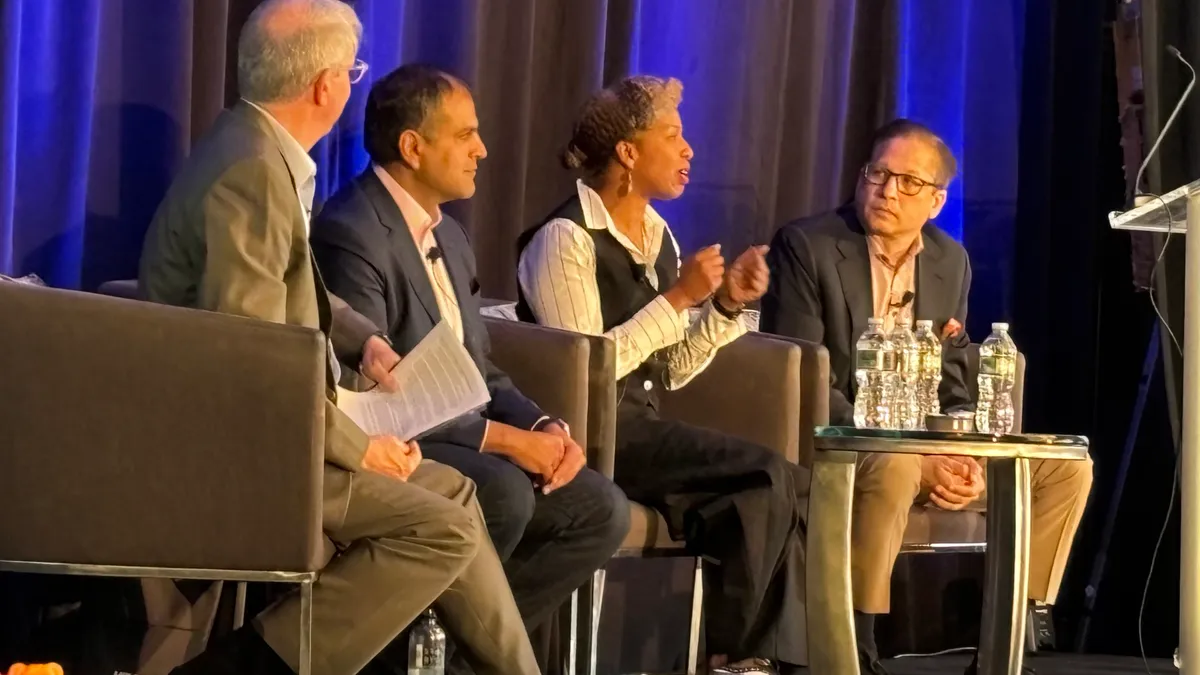CAMBRIDGE, Mass. — As enterprise aspirations for the growing class of large language model technologies gains traction, technology executives cautioned prudence and emphasized the need to cultivate broader awareness and deeper understanding of the tool during the MIT Sloan CIO Symposium Tuesday.
“There are people clamoring for AI all over your organization,” Akira Bell, SVP and CIO at analytics consultancy Mathematica, said. “How many of them do you think really understand what it is they're asking? Do they have a problem they're trying to solve or do they just want to be in the game?”
New enterprise technologies drum up enthusiasm and train a spotlight on the CIO. But emerging tools can also overshadow tried and true IT solutions with a proven enterprise track record.
“People are using the term AI very loosely right now,” said Bell. “One of the things I want them to understand is the difference between generative AI and old-school AI and automation.”
Bell wants to use the interest in generative AI to enhance IT IQ across her organization. She also sees potential in AI capabilities that existed before ChatGPT’s 2022 release changed the narrative around the technology.
“One of our jobs as CIOs is not to get so swept up in generative AI that we don’t make use of all the tools that are available to us,” Bell said.
“We haven't fully saturated the opportunity space with old-school AI. We haven’t finished our automation work. We haven’t finished our data science work. We haven’t finished saturating machine learning,” she added.
How top tech chiefs deploy AI
Bell, a finalist for this event’s annual CIO Leadership award, spoke on a panel with fellow finalist Fahim Siddiqui, Home Depot EVP and CIO, and Chris Bedi, chief digital information officer at ServiceNow and this year’s winner.
The three top tech chiefs explored strategy, recounting wins in the past year as they contemplated future plans for the technology.
Home Depot leaned on its partnership with Google Cloud to improve inventory management at the retailer’s nearly 2,500 stores, a process that began several years before OpenAI helped trigger last year’s generative AI gold rush.
Siddiqui used the hyperscaler’s machine learning and computer vision capabilities to build a tool that may now benefit from generative AI integrations, he explained.
“We had a concept where we needed our associates to take pictures of our entire warehouses so we could do vision processing,” he said. “We had to build the technology, which meant training the engines.”
Scaling the operation required a low-tech solution: buy-in from Home Depot’s army of associates. “We had to balance the high-tech with change management,” Siddiqui said.
The company created incentives to gamify the process, which now yields more than 4 million images per month. Home Depot has more than 175 AI pilots running across the organization, some using generative AI and others relying on traditional machine learning, Siddiqui said.
Software provider ServiceNow followed a two-pronged approach to tapping generative AI’s potential, according to Bedi. The company used the technology to achieve incremental improvements to existing processes while also exploring more ambitious use cases.
“Mode one is easier to attain,” Bedi said, pointing to generative AI assistants that enhance customer support agents, software engineers and sales associates.
The technology, according to Bedi, is already up to those tasks: ServiceNow has more than 20 generative AI use cases in production.
The bigger challenge, he acknowledged, is starting with a blank slate and reimagining what processes can be put more fully in the hands of the technology in order to free up employees for more interesting work.
The generative AI lever
Like many tech-driven businesses, ServiceNow, Mathematica and Home Depot had old-school AI programs. In the absence of strong tech leadership, previous enterprise AI efforts risk languishing in the shadow cast by massive LLMs.
“We were all doing interesting things with machine learning and when ChatGPT came out a lot of us just skated right past ML, as if it were a checked box and we had fully exploited it,” Bedi said, noting the technology still has a lot of untapped value.
Bell sees promise in integrating generative AI capabilities with existing technologies.
“I think the magic is going to come from a combination of generative AI with machine learning and automation,” she said.
Sanjay Srivastava, chief digital strategist at IT services firm Genpact, wants CIOs to seize the generative AI moment to push a broader agenda, using the new technology as a lever to drive ML and automation initiatives.
“Here’s what you do,” Srivastava said, speaking on a separate panel with Bell. “The generative AI hype is so high, and people are so focused on it that you use that train to drive all the data science, the data foundation and the machine learning through,” adding that generative AI is “the final layer.”





















